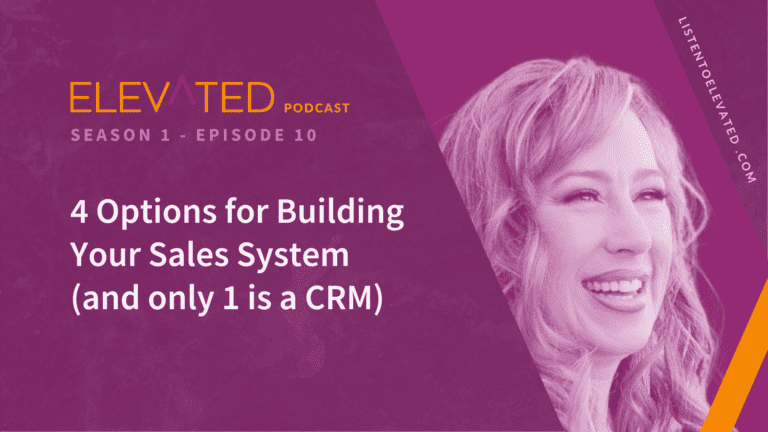4 Options for Building Your Sales System (and only 1 is a CRM)

The right system for any part of your business is the one you will use and that fits your needs. It is also beneficial if it is able to grow with you. But sometimes in business we can only do what we can do at the moment. Which might mean that taking on a Customer Relationship Management (CRM) software implementation is currently out of the question.
Exploring Alternatives: Building a Sales System Without a CRM
Not to worry, there are other ways of powering a sales system. It doesn’t necessarily require a CRM. Before we go further, I will say that businesses planning to grow do need a CRM. Even if you are a one-designer show right now. And, there are lots of different options for a CRM out there. A scalable sales system doesn’t require a massive software investment.
Exploring Lead Data Management: From Spreadsheets to CRM Solutions
A sales system is the information management that powers your sales process. By definition, it needs to be able to store data in a logical way that the data can be easily accessed and used. To meet these needs, we’ll talk about 4 options for how to store your lead information. Spoiler alert, one of them is a CRM. Each of the options we discuss has implementation options that range from simple to complex.
- Spreadsheet – Ah, the good ol’ spreadsheet. The go-to tool for almost any business need. Used by every business function from marketing to finance. And in this case, sales. You can absolutely use a spreadsheet to track your lead information and power your sales system. If you are just getting started and a CRM feels like too much for you, then start with a spreadsheet. Just don’t stay there too long.
The Limitations of Spreadsheets for Long-Term Sales Data Management
It isn’t going to be a shock when I tell you that a spreadsheet will only scale so far. Now, I have seen some monster programming in spreadsheets to get them to function as a CRM. While it’s certainly impressive, sustainability becomes a concern. As the spreadsheet grows in complexity, it also becomes more fragile, leading to added stress. Typically the mad genius behind the spreadsheet starts out eagerly adding functionality and improving it. Then, maybe after a while changes take longer and when things break they aren’t fixed very quickly. And finally, that mad genius might leave the company, and likely never documented how any of it worked.
Exploring Advanced Data Management Beyond Spreadsheets with Airtable
So, spreadsheets are a fine place to start, but to prevent future issues you’ll want to move to something more sustainable before you start dumping too many resources into DIYing your spreadsheet into a CRM.
- More than a Spreadsheet: A step up from a spreadsheet is to use a program called Airtable. They describe their software as a spreadsheet-database hybrid. Users familiar with spreadsheets will feel right at home in Airtable, and then discover they can start to harness more advanced functionality that is perhaps possible with coding in spreadsheets, but can be done without code in Airtable. Airtable even comes with a CRM template.
Harnessing the Power of Modern Data Management Systems: Beyond Project Management
Airtable is a more scalable choice than a spreadsheet as it has advanced features that enable storing, interfacing and viewing your lead data without code or customization.
- Project management system: This category of software applications has massively evolved in the last 5 years. Most of the programs in this category are really more “data management” systems than project management as the way they allow for configuring, inputting and interfacing with data transcends just project management. A few of these types of apps are: Monday.com, Asana, ClickUp, or Wrike.
Exploring Versatile Options for Your Sales System
If you are already using one of these systems for project management, you can also start using it for your sales system. Building out your sales system in one of these apps can be challenging because there are SO MANY different ways to do it. However, most of these programs also have CRM templates you can use as a starting point. This is a great choice if you already have this software in use as it is ready to scale with you.
- CRM: As you might have inferred by now, a CRM is just a specialized data management system. And the options in this category are vast. You can have a CRM app that lives inside your inbox like Streak for Gmail or Outlook CRM. You can use a free option like Zoho CRM or Hubspot. Or you can jump in the deep end with Pipedrive or Cloze. And there’s probably a few hundred other options I haven’t named.
CRMs have the benefit of being specialized for sales, so less decision-making and invention is needed from you. Choosing the right fit does take some time & effort, as well as implementing it in your business and getting everyone trained and using the system. But, once it is in place, it scales with you.
Whichever option you choose, setting up the system will take some investment of time and resources. Sometimes it makes sense to get an expert in to help, as they can lessen the decision-making burden by guiding you through the process and helping you with the implementation and onboarding.
In the next episode we’ll talk about being on the other side of having your lead information in a system and discuss the “now what” of using your chosen sales system platform.
High-er Help, my book on how to use experts to shortcut improvement, growth & capacity is now available! Get all the details and buy it by going to higherhelpbook.com.
Was this episode helpful? Take a moment to rate & review this podcast. Rating us helps other Kitchen & Bath design business owners discover our episodes.

